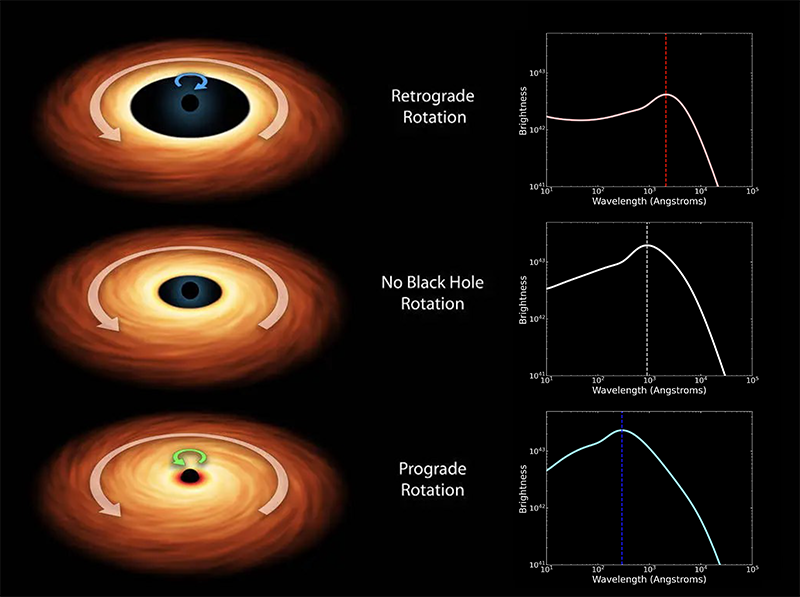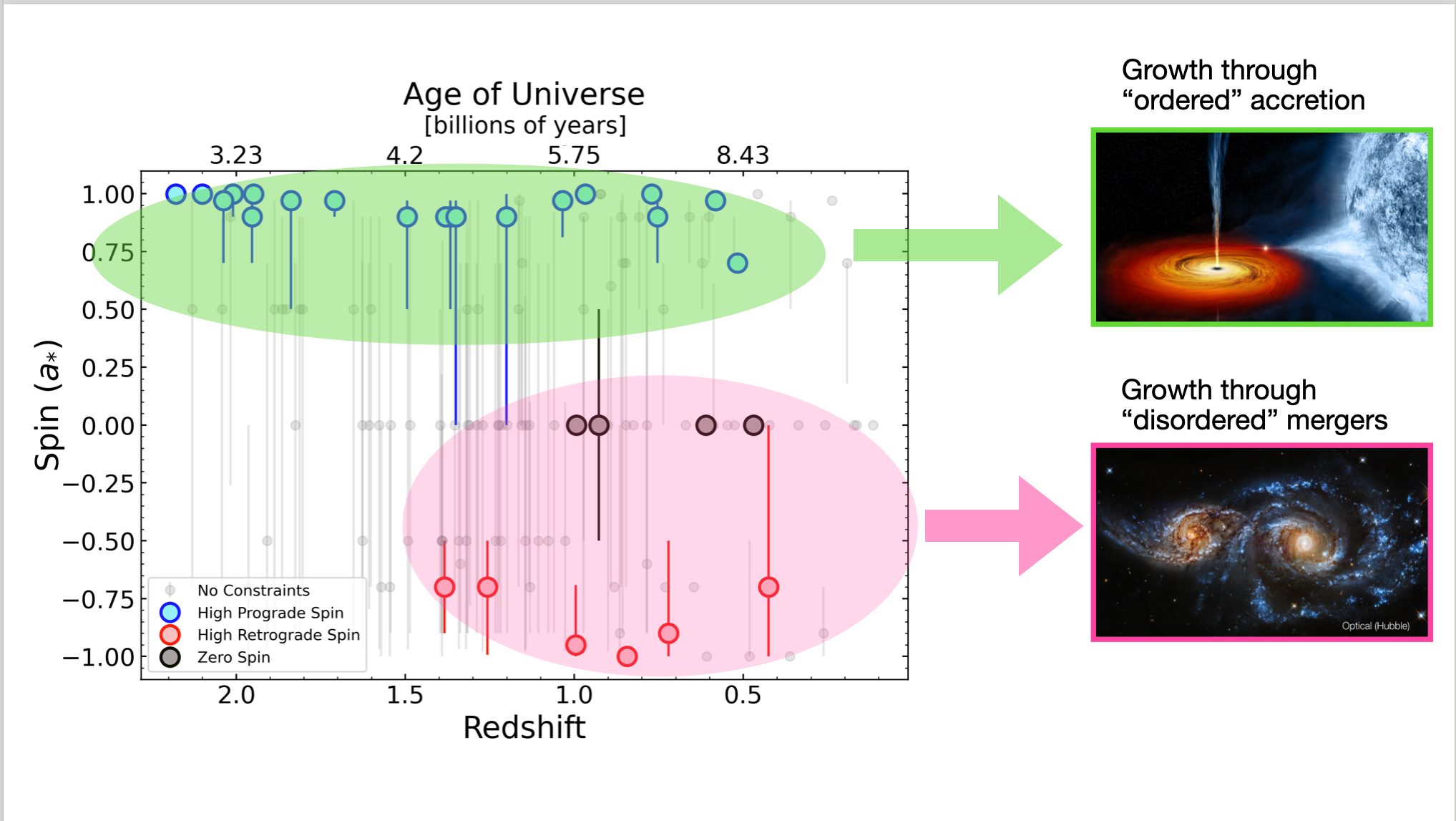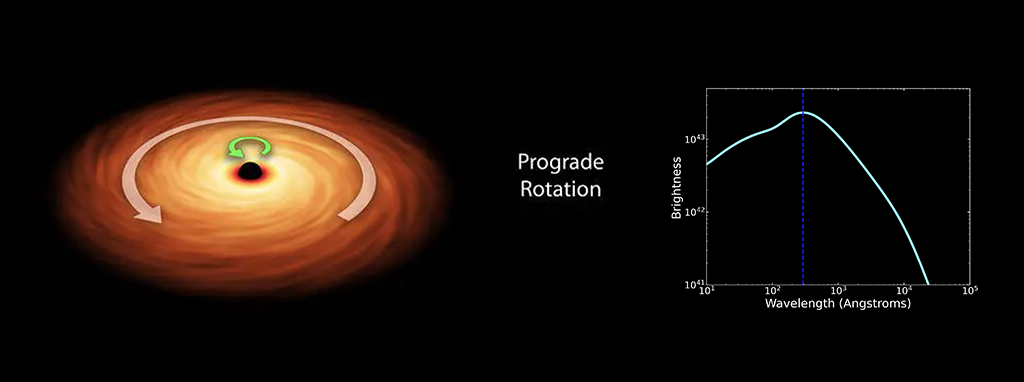Astronomers from the Sloan Digital Sky Survey have measured the rotations of black holes over seven billion years of cosmic history
A new study from the Sloan Digital Sky Survey (SDSS) has revealed a surprising truth about black holes: they spin faster than previously thought, revealing a more orderly early universe than we ever suspected.
“We have studied the giant black holes found at the centers of galaxies, from today to as far back as seven billion years ago,” said Logan Fries, a PhD student at University of Connecticut and primary author of the study. “Unexpectedly, we found that they were spinning too fast to have been formed by galaxy mergers alone. They must have formed in large part from material falling in, growing the black hole smoothly and speeding up its rotation.”

The peak (brightest wavelength) of the spectrum is different in each case. By looking at a real black hole and comparing its peak wavelength to the observed position of these predictions, astronomers can determine its spin. By finding the spins of many black holes, they can do “galactic archaeology” to reconstruct the history of how black holes formed.
Image Credit:
Left: NASA/JPL-Caltech
Right: Logan Fries and the SDSS collaboration
A new study from the Sloan Digital Sky Survey (SDSS) has revealed a surprising truth about black holes: they spin faster than previously thought, revealing a more orderly early universe than we ever suspected.
“We have studied the giant black holes found at the centers of galaxies, from today to as far back as seven billion years ago,” said Logan Fries, a PhD student at University of Connecticut and primary author of the study. “Unexpectedly, we found that they were spinning too fast to have been formed by galaxy mergers alone. They must have formed in large part from material falling in, growing the black hole smoothly and speeding up its rotation.”
Fries announced the findings today at the 245th meeting of the American Astronomical Society (AAS) in National Harbor, Maryland. He explained that the history of black hole growth has not been well-studied, because it requires measurements far more precise than were previously possible.
“Black holes seem so exotic, but you can describe them completely with just two numbers: mass and spin rate,” Fries said. “The problem is that mass is hard to measure, and spin is even harder.”

The green oval shows what would be expected from black hole growth by smooth accretion; the pink oval shows what would be expected from mergers (the illustrations on the right show the corresponding physical system. Most spin values are in the green area – especially in the early universe – suggesting that supermassive black holes are built up mostly from accretion.
Image Credit:
Left: Logan Fries and the SDSS collaboration
Top right: NASA, ESA, and The Hubble Heritage Team (STScI)
Bottom right: NASA/CXC/M.Weiss
The new results are made possible by the SDSS’s Reverberation Mapping project, which has measured extremely precise masses for hundreds of black holes. The project has also made detailed observations of the black holes’ “accretion disks,” the region where matter heats up as it begins to fall into the black hole. Once astronomers know both the mass of a black hole and the detailed structure of the accretion disk, they can begin the challenging task of measuring the rate at which the black hole spins.
“The challenge lies in separating the spin of the black hole from the spin of the accretion disk surrounding it,” said Jonathan Trump, Professor of Physics at University of Connecticut and Fries’s PhD advisor. “The key is to look at the innermost region, where gas is falling into the black hole’s event horizon. A spinning black hole drags that innermost material along for the ride, which leads to an observable difference when we look at the details in our measurements.”
Those measurements consist of spectra – graphs of the amount of light given off at different wavelengths. Fries, Trump, and colleagues used those SDSS spectra, supplemented by others from other astronomy projects. They looked for a subtle shift in the spectra toward shorter wavelengths, indicating rotation of the black hole.
“I call this approach ‘black hole archaeology,’ because we’re trying to understand how the mass of a black hole has grown over time. By looking at the spin of the black hole, you’re essentially looking at its fossil record,” Fries said.
Contacts
Logan Fries
University of Connecticut
logan.fries@uconn.edu
Juna Kollmeier
Survey Director, Sloan Digital Sky Survey
jak@carnegiescience.edu
Jonathan Trump
University of Connecticut
+1 (860) 486-6310
jonathan.trump@uconn.edu
The key to reading that ‘fossil record’ embedded in each black hole is to compare its observed spin rate to what would be expected from different models of how black holes change over time. The prevailing theory up until now is that supermassive black holes mostly grew from mergers between smaller galaxies. That theory predicts that when two galaxies merge, each galaxy has its own rotation rate and is oriented in a random direction – and these rotations are just as likely to cancel out as to add together.
Given that theory, Fries and colleagues would have expected to see a wide range of spins, with most black holes having not much spin at all. Instead, they found that many black holes spin quickly, and that black holes in more distant galaxies spin even more quickly than those in the nearby universe. That suggests, perhaps surprisingly to some theorists, that supermassive black holes built up smoothly over cosmic time by absorbing dust and gas through their accretion disks. Predictions based on their new idea will be tested by future observations from telescopes like the James Webb Telescope, which has been finding supermassive black holes in the early Universe that are more massive than we expected.
“Black holes really do sit at the frontier of human understanding. We undertake massive surveys like SDSS to build an empirical astrophysical picture of their fundamental properties against which our theoretical models can be put to the test,” said Juna Kollmeier, the Director of SDSS-V, the current phase of the SDSS.
About the SDSS
Funding for the Sloan Digital Sky Survey V has been provided by the Alfred P. Sloan Foundation, the Heising-Simons Foundation, the National Science Foundation, and the Participating Institutions. SDSS acknowledges support and resources from the Center for High-Performance Computing at the University of Utah. SDSS telescopes are located at Apache Point Observatory, funded by the Astrophysical Research Consortium and operated by New Mexico State University, and at Las Campanas Observatory, operated by the Carnegie Institution for Science. The SDSS web site is www.sdss.org.
SDSS is managed by the Astrophysical Research Consortium for the Participating Institutions of the SDSS Collaboration, including Caltech, the Carnegie Institution for Science, Chilean National Time Allocation Committee (CNTAC) ratified researchers, The Flatiron Institute, the Gotham Participation Group, Harvard University, Heidelberg University, The Johns Hopkins University, L’Ecole polytechnique fédérale de Lausanne (EPFL), Leibniz-Institut für Astrophysik Potsdam (AIP), Max-Planck-Institut für Astronomie (MPIA Heidelberg), Max-Planck-Institut für Extraterrestrische Physik (MPE), Nanjing University, National Astronomical Observatories of China (NAOC), New Mexico State University, The Ohio State University, Pennsylvania State University, Smithsonian Astrophysical Observatory, Space Telescope Science Institute (STScI), the Stellar Astrophysics Participation Group, Universidad Nacional Autónoma de México, University of Arizona, University of Colorado Boulder, University of Illinois at Urbana-Champaign, University of Toronto, University of Utah, University of Virginia, Yale University, and Yunnan University.

